Hope springs eternal
Samangie Wettimuny
On a tour of Japan
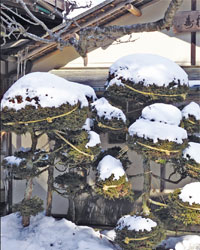 |
|
Chusonji Temple site covered with snow |
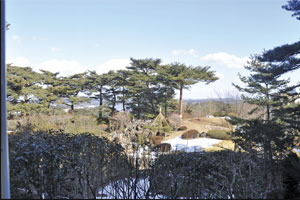
A breathtaking view on the way to Onigawa town |

Chusonji Temple |
“Nature repairs her ravages - repairs them with her sunshine, and
with human labour….” wrote George Eliot way back in 1860. Hundreds of
years later while walking on the paths of Miyagi, Iwate and Fukushima
prefectures in the land of Cherry Blossoms and seeing the punctuality,
undying determination and courage of its people who have made a massive
progress in terms of reconstruction since the Great East Earthquake , I
wondered whether I could rewrite Eliot’s famous lines… “Nature repairs
her ravages – repairs them solely with human labour!”
In just three days time, on March 11, Japan will mark the first
anniversary of 3/11 catastrophe- the worst calamity that hit the country
since the end of World War II- remembering those who lost their lives to
mother nature's fury. Nature, however, is considerate enough to give a
prior warning before hitting us hard, unlike the day the Japanese
experienced man’s inhumanity to his own race in its extreme sense when
the USA dropped massive atomic bombs on Hiroshima and Nagasaki in August
1945, the negative results of which are still being felt. Anyway just as
the Hiroshima Nagasaki attack was a challenge to Japan to emerge as a
world’s super power, the 3/11 catastrophe which is usually referred to
as a “crisis in the midst of a crisis” has once again awakened the
obligations of the Japanese to their country and their commitment to
serve their mother land.
The earthquake, tsunami and the resulting nuclear power plant
accident hit Japan when the country had already been facing a difficult
situation resulting from stagnation of the economy and a social impasse.
Today Japan is facing additional challenges of recovery and
reconstruction from the Great East Japan Earthquake and control of the
nuclear accident. Over 15,700 died, 4500 went missing and over 5700 were
injured as a result of 3/11. The number of evacuees were over 124,000.
Damaged stocks in disaster areas are buildings worth approx 10.4
trillion yen, lifeline utilities worth 1.3 trillion yen, social
infrastructure approx. 2.2 trillion yen, others including agriculture,
forestry and fisheries approx. 3 trillion yen.
Yet the Japanese continue to display their never-say-die spirit. Once
again they are determined to prove to the world that from catastrophe
springs fortune if there is enough patriotism and hard labour!
As Japan’s Deputy cabinet secretary for Public Relations/Director of
Global Communications Noriyuki Shikata said in an exclusive interview
with the invited press members around the world, out of the three worst
affected prefectures namely Iwate, Miyagi and Fukushima , the case of
the latter is very unique due to the Fukushima Daiichi Nuclear Power
Plant Accident. “We have a long way to go in decontaminating the
Fukushima prefecture and the government is taking extra precautions to
ensure that people in Fukushima could live safely.”
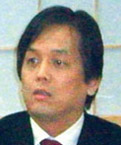 |
 |
 |
Joe Nakano, Parliamentary
Vice-Minister for Foreign Affairs |
Noriyuki Shikata
Deputy Cabinet Secretar y for Public Relations |
Tetsuo Saito, Deputy Director Genearl for Economic and
Fiscal Policy Management |
The 3/11 calamity has brought a number of policy related challenges
particularly in relation to energy policy review. Before 3/11 the
Japanese government has targeted at increasing the proportion of the
nuclear power plants from about 30% of power generation to over 50 %.
“We were planning to build extra power plants. But now after 3/11 we
have decided to reassess this energy policy. In Japan the cost estimate
has always indicated that nuclear power is much cheaper than others. But
when we were carrying out independent assessment of the cost, and when
you take into account the possible domestic environment compensation
cost and also disposal of nuclear waste, moving to renewable energy
stands as a better option” He said.
Japan is already the world’s number one in terms of energy efficiency
and they intend to increase it even further. What was emphasized by
Deputy Director Genearl for Economic and Fiscal Policy
Management.,Cabinet office , Tetsuo Saito was the necessity to change
the energy policy and take necessary measures to increase the
productivity.
Assistance
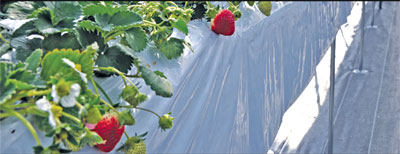
Yamamoto strawberry cultivation |

Trees in winter |
Joe Nankano, parliamentary Vice Minister for Foreign Affairs and
Member of the House of Representatives said that more than the disaster,
false rumours have damaged the process of recovery. He also recollected
how almost all the countries reached out to Japan in whatever way they
can. “We keep on assisting countries and when the Great East earthquake
struck us they helped us in return. Though tourism is not yet back to
normal in the affected prefectures, a massive progress could be
observed. So please tell the world what you see.” He said with emotion.
Seeing is believing! Japan have successfully embarked on its rebirth
efforts, exploring new frontiers, and opportunities created by
overcoming crises and harnessing new potential for growth. After the
earthquake the Japanese started facing new issues such as damage caused
by radiation, which came in three ways pollution, rumours and fear, then
supply restrictions - power shortage, damaged supply chains, weakened
competitiveness.
Now the country is thinking of new innovative and environmental
strategies, revitalization of agriculture, forestry and fisheries
industry, encouraging a growth –oriented longevity society and regional
revitalization as well as energy strategies.
Fukushima, Iwate and Miyagi prefectures where we were touring were
severely damaged. Despite the massive destruction caused by 3/11, the
people of these prefectures still hold on to their optimistic views of
life. When the paddy farming was hard hit in the aftermath of the
tsunami, with soil getting salty, and with business prospects seemingly
bleak in those areas, the Japanese however did not call it quits. We
could see how local communities and volunteer organizations and
companies have got together to expedite the reconstruction process.
Recovery shopping street
“Hotto Suru Kokoro no Yokocho” in Ishinomaki city, Miyagi prefecture
which is called disaster recovery shopping street is a fine shopping
district created with 16 trailer houses. As our interpreter explained to
us within 100 days after its conception, it has attracted various
opening shops. The site has been selected because it is the closest
suitable site to the affected areas in the Miyagi prefecture. It has
many companies including the major food chain “Hotland.”
“This is a fine place to have a hot drink, a snack or simply
anything” said a Japanese girl “Now more and more people are coming”.
Though none of her immediate relatives died as a result of the tsunami,
she shared the worries with everyone.
This shopping street is not only a temporary volunteer help but also
provides constant business based support.
The plight of Fukushima
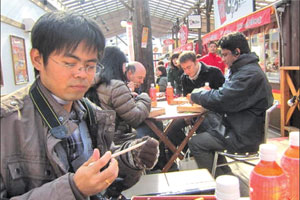
A scene from Hot Yokocho Ishinomaki: a shopping district
of recovery |

Towa Co, Ltd, Motomiya City, Fukushima Prefecture |

Sendai, the capital city of Miyagi prefecture |
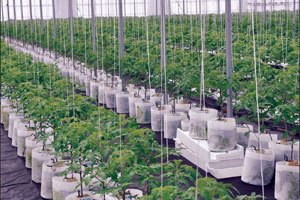
Saizeriya Tomato hydroponic cultivation farm |
Fukushima being the prefecture where the much talked of nuclear power
plant is situated, a large number of people fled the area following the
nuclear leakage. The earthquake shook the region with an intensity
greater than 5 on the seismic scale and the emotional shock on its
people was graver than the physical damages. In the wake of such
damages, projects such as Ganbaro-Fukushima (GF) were launched to
promote the purchase of Fukushima prefecture textile products both in
Japan and abroad , thereby supporting through such economic activity and
textile industry.
Towa Co ltd, in Motomiya city, Fukushima is a GF project
participating company which is well known for producing uniforms,
overcoats has 6000-8000 production capacity and has been in operation
since 1948. According to GF project representative Hirotoshi Kato and
Towa president Keiichi Sato “Things are gradually improving and sales
are gradually back to normal.”
Today the employees are working in the factory efficiently and neatly
stitched overcoats and uniforms are on sale. The factory has made the
maximum use of the division of labour.
When talking of reconstruction efforts the services rendered by
Takamasa and Co Ltd, Onagawa is praiseworthy. It assists the recovery of
the Onagawa city in various ways.
The radiation fear made a negative impact on the fisheries industry
and marine products. Takamasa Director Masaki Takahahi says he has taken
various measures for the recovery in Onagawa town. As an attempt to
ensure consumer safety Takamasa Co Ltd conducts product testing with
privately purchased food radiation measurement system. Since the
disaster the company has employed 52 individuals residing in disaster
afflicted regions and by the end of March they intend to hire ten more.
Through collaboration between the Onagawa fish market and Takamasa & Co
Ltd , action was taken to ensure fish safety by acquiring radiation
measurement data for fresh fish unloaded at Onagawa port.
In the midst of struggling to push the economy back to normal today
the Japanese government is entrusted with extra load of work.Radioactive
materials in food are being checked every day in the affected regions
and the distribution of food that fails to meet provisional regulation
values is restricted taking into consideration the spread of
contamination. In order to ensure the safety of fishery products a
thorough inspection is done over a wide range of samples.
To ensure the safety of drinking water the Japanese government has
been implementing necessary measures based on its stringent criteria for
radionuclides in drinking water, and monitoring radionuclide levels
every day. To ensure the safety of industrial products inspection
institutions and industry associations provide testing service of the
radiation levels of export products.
Strawberry plantations
Yamamoto town in Miyagi Prefecture which is famous for strawberry
cultivations too was hit by the Great East earthquake.
Tsunami has devastated 90% of Yamamoto’s strawberry cultivation
facilities and as a result the number of farming households producing
strawberries reduced drastically. However “Yamamato strawberry
Plantation Inc” that we visited had been launched in this backdrop with
three farming households in Yamamoto town setting out to create a
tourist farm.
“In early June of 2011 we launched our own joint stock corporation
and we intend to deliver our strawberries to the market in the spring of
2012,” said its owner. In this farm strawberry is cultivated above the
ground level, a method which is called aeroponics.
In fact as a measure of “restoration of Yamamoto town’s agriculture
leading to overall regional recovery”, this company thought to turn
their family operated agriculture business to a venue of regional
development. Thus the undying determination and courage of the Japanese
always play a major role in saving the country during crisis situations.
Saizeriya Tomato Hydroponic cultivation farm , Sendai city, Miyagi
prefecture, too is an effort to recover the economy. All of this
farmland originally consisting of paddy fields, was completely covered
with sea water from the earthquake. It uses cost reduction methods, and
manure and water are supplied through tiny pipe lines. The Saizeriya
hopes that this farm will become competitive force in the next ten
years.
Hiraizumi
Visiting the Hiraizumi town in Iwate prefecture which was registered
as a World Heritage Site in June 2011 was a wonderful experience.
According to the chief priest of Chusonji Temple, during the first long
vacation after tsunami, Hiraizumi suffered a loss of more than 85% of
tourists during the ‘Golden Week.” However after being declared as a
world heritage site there have been positive trends in terms of the
number of tourists.
Having experienced a tsunami 11 years ago , I am no stranger to its
aftermath. We know how we all suffered as a nation and how we tried to
overcome the physical and emotional damages… Japan being a world
economic power house and Sri Lanka yet being a developing country do not
make much of a difference. However different we may appear there is far
more that unites us than devides us -. Our willingness to help each
other in distress and it is a pleasure to see we are getting genuinely
appreciated on what we do. At the lunch hosted by the Press secretary of
the Japanese Foreign Ministry one of the officials of the Ministry told
me that Sri Lankans sent a massive amount of tea packets when the
disaster struck “to keep us warm”.
Touring the tsunami affected areas of Japan , seeing the massive
reconstruction efforts launched by the Japanese government, it was easy
to realize that the attainment of a worthwhile goal is a rewarding
accomplishment. The Land of the Rising Sun has proven once again that
for as long as the sun rises, through visualization, determination and
resilience, success is guaranteed.
Step by step, one walks far.
[email protected]
(The tour was organized by the
Ministry of Foreign Affairs, Japan) |



